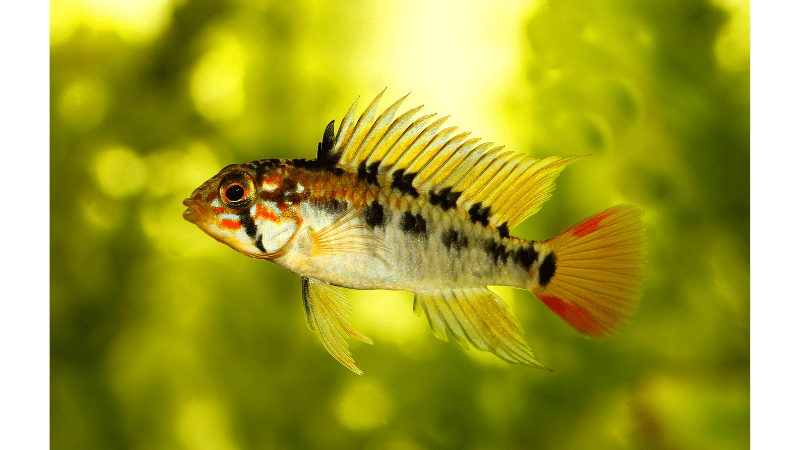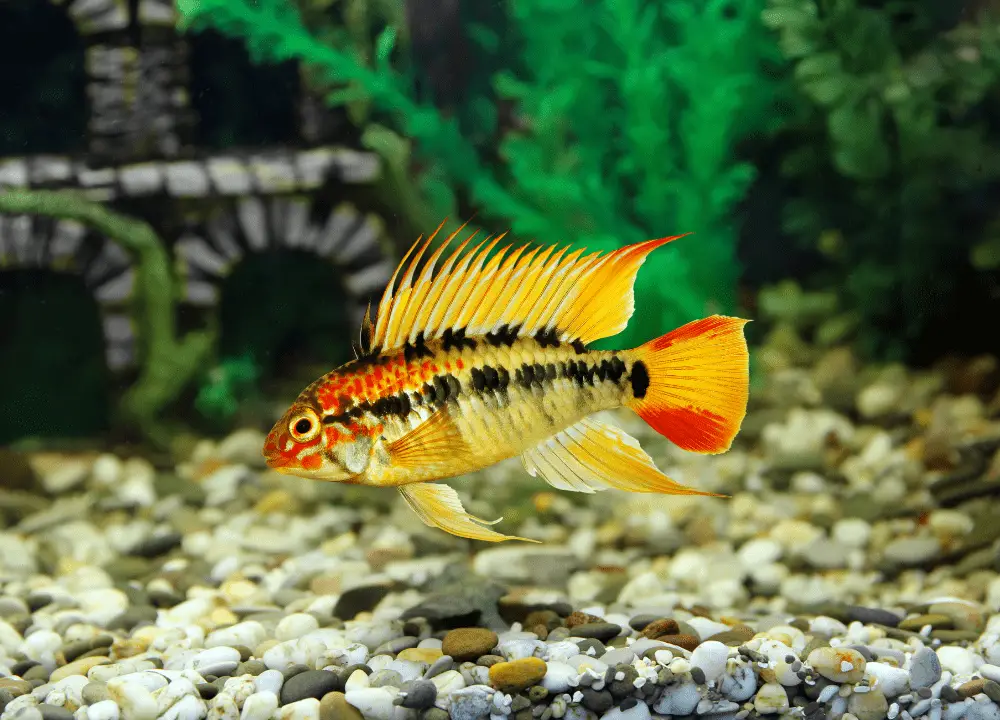The Apistogramma macmasteri is a dwarf cichlid native to Columbia’s freshwater habitats. Known for their bright coloration and complex behavior, these fish are popular among aquarists.
Apistogramma macmasteri, also termed the Macmaster’s Dwarf Cichlid, presents a captivating addition to tropical freshwater aquariums. Reaching only 3 inches in size, these diminutive fish boast vibrant hues of yellow, red, and blue, particularly pronounced in males during spawning. Enthusiasts prize the species for its intricate social structures and courting rituals.
Originating from South America, Apistogramma macmasteri thrive in soft, slightly acidic water mimicking their natural Amazon River tributaries. They require well-planted tanks with ample hiding spots to replicate their wild environment, support their wellbeing, and bring out their best behavior and coloration. Maintaining a peaceful community tank, these dwarf cichlids contribute a dash of color and dynamism to the aquascape, making them a coveted choice for dedicated hobbyists.
Table of Contents
Physical Characteristics Apistogramma Macmasteri
The dazzling Apistogramma macmasteri, esteemed among aquarium enthusiasts, flaunts distinctive features that contribute to its popularity. Let’s delve into what makes this fish a visual marvel in a home aquarium.
Size
Compact and charismatic, the Apistogramma macmasteri typically reaches an adult size of about 3 inches (7.6 cm) in length. They are perfectly sized for smaller tanks, and this manageable size contributes to their widespread appeal.
Coloration
This species exhibits a fascinating array of colors, with notable variations such as Apistogramma macmasteri gold and super red. Males often showcase a bright red mask and opulent shades of blue, yellow, and red. Females may not be as colorful but have a subtle charm with a golden hue.
| Variant | Main Color | Highlights |
|---|---|---|
| Gold | Golden Yellow | – |
| Super Red | Deep Red | – |
| Wild Type | Olive/Brown | Bluish Spots |
The Apistogramma macmasteri wild type presents a more subdued palette, with a base of olive or brown colors complemented by iridescent blue spots.

Fins
Pronounced fins are hallmarks of the male Apistogramma macmasteri, with elongated dorsal and caudal fins. These add to their striking appearance during displays and courtship. Female fins are typically shorter but are still graceful and add to the delicate aesthetic of this dwarf cichlid.
- Males: Elongated, Pointed Fins
- Females: Shorter, Rounded Fins
Behavior And Temperament Apistogramma Macmasteri
The Apistogramma macmasteri, a jewel of the aquarium hobby, displays distinctive behavior. Understanding their social structure and reproductive behavior is key for a harmonious tank. Let’s dive into the fascinating world of these colorful dwarf cichlids.
Social Structure
Apistogramma macmasteri exhibit a complex social structure. In the wild, they form hierarchical relationships within their communities. In an aquarium setting, this behavior can still be observed.
- Dominant males control territories and boast more vivid colors.
- Females and subdominant males establish a pecking order.
- Ensuring plenty of hiding spots and territorial boundaries, like plants or caves, prevents conflicts.
Provide adequate space for each fish to reduce stress and promote well-being.
Reproductive Behavior
During breeding, the Apistogramma macmasteri behavior shifts remarkably. The male’s colors become even more vibrant to attract mates.
- Females prepare a nesting site, usually under a leaf or in a cave.
- Males then display to and court females with elaborate dances.
- After spawning, females guard the eggs fiercely while males protect the territory.
A well-structured environment with ample breeding sites encourages natural reproductive behavior.

Feeding Habits
Understanding the dietary needs of Apistogramma Macmasteri is crucial for their health and vibrancy. These dwarf cichlids have specific feeding habits that, when catered to, ensure they thrive in aquarium settings. Let’s explore their diet and feeding routines.
Diet
The core diet of Apistogramma Macmasteri includes a range of live and frozen foods. Protein-rich options like brine shrimp, bloodworms, and daphnia offer the nutrients they need. They also enjoy high-quality flake foods and pellets, suitable for small mouths.
Feeding Habits
Apistogramma Macmasteri prefer a feeding schedule that mimics their natural environment. Small, frequent feedings are better than one large meal. Two to three feedings per day will suffice. This routine helps prevent overfeeding and maintains water quality.
- Live Foods: Encourage natural hunting behavior.
- Frozen Foods: Convenient yet nutritionally substantial.
- Flakes and Pellets: Formulated foods provide a balanced diet.
Be sure to observe your fish during feeding times. This practice helps identify any changes in appetite or behavior, which may indicate health issues.
| Time of Day | Type of Food | Amount |
|---|---|---|
| Morning | Flakes/Pellets | Small pinch |
| Afternoon | Frozen Brine Shrimp | As per feeding guide |
| Evening | Live or Frozen Daphnia | As per feeding guide |
Regularly vary their diet for optimal health and coloration. Always remove uneaten food to prevent water contamination.
Housing And Tank Requirements
For Apistogramma macmasteri, a well-set-up tank is key to their health and happiness. Understanding the tank and water requirements will ensure these colorful fish thrive. Let’s delve into the specifics of their housing needs.
Tank Size
Apistogramma macmasteri feel most at home in tanks that mimic their natural environment. Aim for a 20-gallon tank for a pair. Larger groups need at least 40 gallons. More space helps reduce aggression and stress among fish.
Water Parameters
Getting the water just right is crucial for these tropical fish. Here’s a simple guide to ensure your tank has the perfect conditions:
| Parameter | Value |
|---|---|
| Temperature | 78-84°F (25.5-29°C) |
| pH Level | 6.0-7.0 |
| Hardness | 3-10 dGH |
| Water Change | 25% Weekly |
Clean, well-filtered water is vital. Include plenty of plants and hiding spots. A sandy bottom replicates their natural habitat and allows for natural behaviors.
You can see all TYPES OF APISTOGRAMMA
Breeding Apistogramma Macmasteri
Breeding Apistogramma Macmasteri offers a unique challenge for aquarists. These fascinating fish exhibit complex behaviors and require specific conditions for successful breeding. Let’s explore the courtship rituals and necessary conditions that lead to breeding these beautiful dwarf cichlids.
Courtship And Pairing
These dwarf cichlids display an intricate courtship dance. The male showcases vibrant colors to attract a mate. He flares his fins and darts around the female. The couple then selects a suitable nesting site for their future brood.
Breeding Conditions
Creating the right environment is key for Apistogramma Macmasteri to breed. They require:
- Soft, acidic water with a pH between 5.0 and 7.0.
- Temperature control around 78 to 84 degrees Fahrenheit.
- A tank setup with plenty of hiding places such as caves and dense vegetation.
To stimulate breeding, feed the pair high-quality, live foods. A small water change with slightly cooler water can also mimic the rainy season, encouraging spawning.
Frequently Asked Questions Of Apistogramma Macmasteri
What Is The Natural Habitat Of Apistogramma Macmasteri?
Apistogramma Macmasteri, or Master’s Dwarf Cichlid, thrives in slow-moving, shallow waters in Colombia, primarily in the Meta River basin. These environments often have dense vegetation and soft, acidic water, providing ideal hiding spaces and breeding grounds.
How To Care For Apistogramma Macmasteri In Aquariums?
Care for Apistogramma Macmasteri requires a well-planted tank with hiding spots, soft acidic water, and a warm temperature between 79-84°F (26-29°C). Regular water changes, a balanced diet, and peaceful tank mates are also essential for their wellbeing.
What Does Apistogramma Macmasteri Eat?
In the wild, Apistogramma Macmasteri’s diet consists of small crustaceans, insects, and larvae. In captivity, they thrive on a varied diet including high-quality flakes, frozen or live brine shrimp, bloodworms, and daphnia, ensuring their nutritional needs are met.
Are Apistogramma Macmasteri Good For Community Tanks?
Apistogramma Macmasteri can be a good addition to a community tank, but select tank mates carefully. They prefer peaceful and similarly sized fish. Aggressive or overly active species should be avoided to prevent stress and territorial disputes.
Conclusion
Exploring the captivating world of the Apistogramma macmasteri is a delight for any aquarist. With their vivid hues and dynamic behavior, these dwarf cichlids truly enliven a tank. Remember, providing suitable water conditions and a well-structured habitat ensures their wellbeing.
Embrace the challenge and the joy these freshwater gems bring to your aquatic collection!


